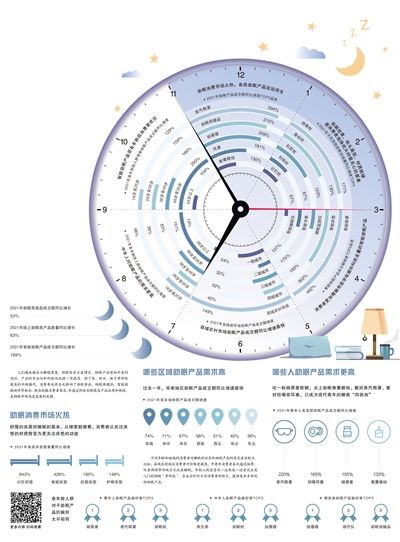
Data source: Jingdong Consumer and Industrial Development Research Institute
Paying for good sleep
In 2021, the average sleep duration of the Chinese people will be reduced from 8.5 hours in 2020 to 7.06 hours. The time to fall asleep is late, the duration of sleep is reduced, and the quality of sleep shows a significant downward trend. Correspondingly, the sleep aid economy is becoming more and more popular, and more and more consumers are willing to pay for good sleep.
In the past, the consumption scene of sleep was relatively simple. People followed the routine of “work at sunrise and rest at sunset”, and only have bedding to meet the basic needs of sleep. Nowadays, the pace of life is accelerating, the pressure of work is increasing, and people’s sleep patterns have changed a lot. Compared with “passive” insomnia, more and more people “actively” stay up late, and the demand for sleep consumption has become more diverse. Among them, the professional and technological demand for sleep aid products has increased the most, which has also broadened a new development track for related manufacturers.
Taking mattresses as an example, consumers have gradually shifted from focusing on materials to focusing more on functions. Partitioned mattresses, smart mattresses, antibacterial mattresses, and spine-protecting mattresses are welcomed by consumers. The blessing of intelligent technology has improved the quality of sleep aid products and enriched product functions, which is an important boost for the mature development of the sleep aid market. Enterprises can continue to enrich their own product dimensions according to different needs, and upgrade homogeneous sleep aid products to functional sleep aid products driven by scenarios and needs.
In addition, the consumer group of sleep aid products is also expanding. From a regional perspective, the county-level rural market has great potential. The purchasing power of residents in rural areas of the county is increasing, and improving the quality of life has become the main driving force for consumption, and the demand for sleep consumption has also changed. The data shows that in 2021, the transaction value of sleep aid products in the county rural market will increase by 149% year-on-year, and the growth rate will far exceed that of first-tier to fourth-tier cities. Relevant manufacturers can develop and produce more products that meet the needs of sleep consumption in the county rural market, and better meet the demands of this consumer group to improve sleep quality and quality of life.
From the perspective of age, sleep problems show a younger trend. Although the main force in purchasing sleep aid products is still middle-aged people, young consumers have more and more urgent demands to solve sleep problems, and their willingness to consume is gradually increasing. Compared with middle-aged and elderly consumers, young people are more accepting of various new sleep aid products such as sleep aids, sleep aid bracelets, sleep aid sprays, and sleep speakers. Relevant companies can launch more “black technology” new products for young people, but they must also pay attention to the efficacy first. Only with the effect of improving sleep quality can they win the love of consumers.
With the improvement of residents’ living standards and the improvement of health concerns, the blue ocean of sleep aid market still has a lot of room for growth. Relevant companies should continue to provide sleep aid products with higher quality, better experience, and better prices through technological innovation, so that more consumers can “have a good night’s sleep”.
(Author Chai Zhenzhen is an industry researcher at JD.com Consumer and Industrial Development Research Institute)